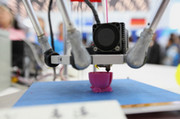 |
| Reviews and Templates for Expression We |
Is 3D Printing the Future of Sustainable Manufacturing?

3D printing increases efficiency and reduces waste, making it a valuable tool in efforts to make manufacturing more sustainable. Its applications range from medical devices to aerospace — and possibly even drinking water.
Earlier this month General Electric announced a project with the Department of Energy that uses 3D printed turbines in a process that could make desalinated seawater 20 percent less costly to produce.
The environmental and economic benefits of 3D printing have the potential to transform traditional manufacturing through cost reductions, energy saving and reduced CO2 emissions, according to a paper published last month in the journal Energy Policy. 3D printing can potentially reduce manufacturing costs by $170 billion to $593 billion, energy use by 2.54–9.30 exajoules (EJ) and CO2 emissions by 130.5 to 525.5 metric tons by 2025, the paper says. The range within the savings is due to the immature state of the technology and the associated uncertainties of predicting market developments.
As 3D Systems, which produces 3D printers and print materials explains on its website, “By its very nature 3D printing is a sustainable technology empowering 3D Systems printers to produce affordable products efficiently — one layer at a time using only the necessary amount of material required for each part with near zero waste in an energy efficient process.”
And Bram de Zwart, co-founder of 3D Hubs, the world’s largest and fastest-growing network of 3D printers, tells Wired magazine that 3D printing is expanding into more applications: “everything from tissue printing in the biomedical industry to custom metal part production in the aerospace industry and everything in between.”
Ross Kozarsky, the senior analyst who leads Lux Research’s Advanced Materials research, tells Environmental Leader that 3D printing makes manufacturing more sustainable by bringing three major factors to the table.
First, it’s more efficient in terms of material consumption, he says. While traditional manufacturing methods employ subtractive manufacturing, which starts with more materials than needed to product products, 3D printing is additive manufacturing. “You are building objects from the bottom up and only using the material where you need it,” Kozarsky says.
This not only reduces waste, but it has a cost savings benefit as well, especially when using expensive materials like titanium, nickel-alloy steels and thermal plastics, for example.
On the flip side, underutilization of materials is an environmental concern with 3D printing, says David Dornfeld, the Will C. Hall Family Chair in Engineering in Mechanical Engineering at University of California Berkeley who also leads the Laboratory for Manufacturing and Sustainability. “It can waste material on low productivity operations better suited to more conventional mass production,” Dornfeld says. “Some processes have a lot of waste compared to the actual material in the product produced for support or because of the operation of the machine. That’s waste.”
Plus, he says, some of the materials produced may not be as easily recyclable.
However, 3D printing allows manufactures to make structures using lighter materials that aren’t possible to make using traditional methods. Kozarsky points to Airbus as an example of how 3D printing enables lightweighting. Airbus’ 3D-printed titanium cabin bracket makes the aircraft more economical to operate; it reduces fuel consumption and related emissions.
The third sustainability benefit of 3D printing, according to Kozarsky, is that it simplifies the supply chain and logistics. “The concept of on-demand manufacturing is a big benefit and a good example of this is off-shore drilling,” he explains. “From an environmental perspective you don’t need to ship a new part you can make it onsite.” This also reduces downtime that results from waiting for a part to be manufactured off site and shipped to the drilling rig.
“3D printing turns the traditional industry supply chains on its head. It allows different entities to do the production of the finished part, cutting down on transportation and logistics, which definitely has a benefit,” Kozarsky says.
In his Wired interview, de Zwart says this supply chain benefit extends to the retail industry as well. 3D printing “has the potential to revolutionize the retail experience through enabling products to be both designed and produced at the point of sale,” he says.
“This method of distributed manufacturing not only eliminates multiple steps from the supply chain that would otherwise result in wasted resources and product, but also lowers the price of the product for the end user,” de Zwart continues. “Additionally, the ability to manufacture, assemble, repair, and upgrade a product at this degree creates a level of connection that just simply hasn’t existed with consumer products before.”
Photo Credit: 3D printing via Shutterstock
|
|
|
|
Copyright 2011 Energy and Technical Services Ltd. All Rights Reserved. Energyts.com |